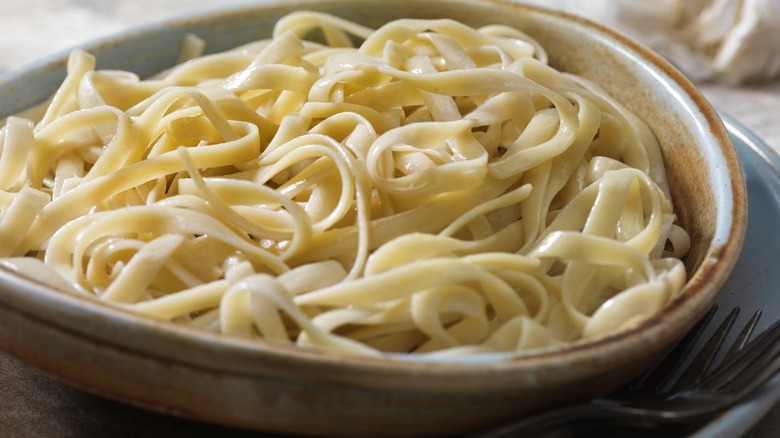The Biggest Difference Between Kluski And Egg Noodles
Noodles are among the simplest foods as they're made with little more than flour, water, and sometimes eggs. On the other hand, there are practically a zillion different kinds of noodles, varying by type of flour (wheat, rice, spelt, etc.) and by shape (rotini, farfalle, linguini, and all the rest). When it comes to egg noodles, that descriptor still doesn't narrow things down much. For example, egg noodles encompass the Chinese type used for chow mein and lo mein and the wide, flat variety typically found in American grocery stores — and then there's kluski.
Kluski is also a kind of egg noodle, albeit one linked to Polish cuisine. (Note: We are not talking about Silesian kluski, which is made with potatoes and similar to gnocchi.) What differentiates kluski noodles from noodles typically marketed as "egg noodles" is that they are made with double the amount of egg. As a result of this extra liquid, kluski does not contain any water, like other egg noodles tend to include. Kluski noodles may also appear thinner than other egg noodles and can look somewhat like short fettuccine or tagliatelle.
Kluski and egg noodles are used in different preparations
In many cases, kluski and egg noodles can be used interchangeably, but each has its area where it shines. Kluski noodles are excellent in soups and are arguably the best chicken soup noodles. Kluski is also featured in several traditional Polish specialties, including casseroles made with cabbage and kielbasa or bacon and one Christmas Eve dish that features noodles mixed with poppy seeds.
The wider, flatter egg noodles most of us are familiar with are a staple ingredient in dishes like tuna casserole, where their more substantial shape allows them to stand up to a mixture of canned fish, frozen peas, and cream of mushroom soup. Egg noodles are typically served with beef stroganoff, too: They can be found in the kind made with steak and in recipes with ground beef. They are also frequently paired with the school cafeteria classic, Salisbury steak, and can even be used to make sweet noodle kugels.

